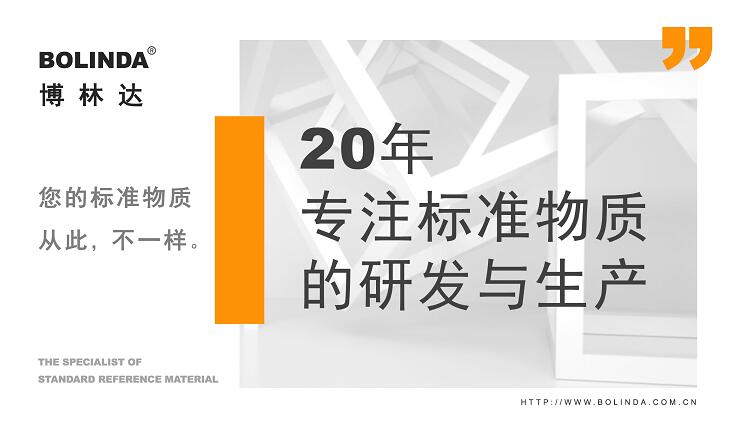2020-02-13 16:58:15
Standard solution refers to a reagent solution with an accurate known concentration, and titrators are commonly used in titration analysis. In other analytical methods, the standard solution is used to draw working curves or as a calculation standard. The following is a small edition of Bolinda to introduce the preparation and calibration method of standard solution.
Preparation of standard solution:
1, the direct preparation method for the pure substance (called the reference substance) can be accurately weighed, dissolved with distilled water, transferred to a certain volume of the volume bottle diluted to the line, the exact concentration of the solution can be directly calculated. The purity and properties of the solute have a greater impact on the concentration, so the following conditions must be met for the reference material used to directly prepare the standard solution:
(1) The purity of the substance should be high, the content should not be less than 99.9%, and the content of impurities should be as little as can be ignored.
(2) The molecular composition of the substance shall be in complete conformity with its chemical formula, including the content of the condensate water in the junction hydrate. Such as borax Na2B4O7·10H2O.
(3) Stable nature, storage should not change, not easy to absorb moisture in the air, carbon dioxide and other gases and change its composition, not easy to weather delixing and air oxidation, drying is not easy to decompose. In addition, it is best to use a reference material with a larger molecular weight to reduce weighing errors.
2, indirect preparation method where does not meet the conditions of the reference material, the substance can be prepared into a solution of approximately the required concentration, and then titrated with the reference material solution or the standard solution that can react quantitatively with it to obtain its accurate concentration, this operation to determine the accurate concentration by titration is called "calibration". When preparing approximate concentration solution by indirect method, it is not necessary to use analytical balance and volumetric bottle, but can use table scale, measuring cylinder and other utensils.

Transfer the measured substance to a clean reagent bottle, first add a small amount of distilled water to dissolve it, continue to add distilled water with the measuring cylinder to the required amount. Since most of the reagents do not meet the conditions of the reference material, the indirect preparation of the standard solution is often used. For example, solid NaOH is easy to absorb moisture in the air and absorb CO2 to deteriorate the surface; Concentrated hydrochloric acid can not be accurately weighed because it is volatile. Potassium permanganate is not easy to obtain analysis of pure grade reagents, etc., the standard solution of these substances must be prepared by indirect method, and then used as a standard solution after calibration.
Calibration of standard solution:
1, with the reference material calibration method
(1) Multiple weighing method Precision weighing several parts (such as 2 to 3 parts) of the reference material with weight reduction method, respectively poured into the number of clean conical bottle (or beaker), dissolved with a small amount of distilled water, and then added the indicator after titration with the solution to be calibrated to the equivalent point, respectively record the volume of the solution to be calibrated, combined with the weight of the reference material to calculate the accurate concentration of the solution, respectively. Finally, the average is taken as the concentration of the standard solution.
(2) pipette method precision weigh a reference substance, add a small amount of distilled water in a clean small beaker to dissolve it, transfer all the glass rods to the corrected volumetric bottle, rinse the beaker liquid several times into the volumetric bottle, and finally mix into a certain volume of solution. Each titration is absorbed with a matching pipette and transferred to a conical bottle. After adding an indicator, the solution to be calibrated is titrated to the equivalent point, and records are made each time. According to the volume of the solution to be calibrated and the weight of the reference material, the accurate concentration of the solution is calculated and the average value is taken as the concentration of the standard solution.
2, comparative method calibration If the solution to be calibrated can react with a standard solution, a certain volume of a standard solution can be titrated with the solution to be calibrated, or a certain volume of the solution to be calibrated with a standard solution. According to the number of milliliters consumed by the two solutions and the concentration of a standard solution, the exact concentration of the solution to be calibrated can be calculated by the formula N1V1=N2V2.
This process of determining the exact concentration of the solution to be calibrated with the standard drop is called "comparative method" calibration. If the concentration of a standard solution is not accurate enough for some reason, it will directly affect the accuracy of the concentration of the solution to be calibrated. Obviously, the comparison method is not as accurate as the method of direct calibration with the reference substance, but the comparison method is simple and easy.
After the calibration is completed, the standard solution reagent bottle is closed, and the name, accurate concentration and date of the standard solution are indicated on the bottle label.
The above content is an introduction to the preparation and calibration of the standard solution. There are two methods for the extraction of the standard solution, mainly the direct preparation of the reference substance and the calibration and extraction of the standard solution with known accurate concentration. The accuracy of the concentration of the standard solution is directly related to the precision and accuracy of the detection results, and the preparation conditions have very strict requirements.





